Report on 501 Developing Teaching, Learning & Assessment in Education
VerifiedAdded on 2023/06/10
|15
|4859
|290
Report
AI Summary
This report delves into the development of teaching, learning, and assessment strategies within education and training contexts. It analyzes pedagogical principles, the effectiveness of creative and innovative teaching approaches, and various theories and models related to inclusive teaching. The report also demonstrates the planning, delivery, and assessment of inclusive teaching practices, along with an analysis of behavioral management theories and the creation of safe and inclusive learning environments. Furthermore, portfolio evidence is presented, showcasing initial assessments, scheme of work development, and the design of teaching and learning plans that cater to diverse learner needs. The document also reflects on the delivery of inclusive teaching and learning and the application of assessment practice theories, models, and principles, concluding with key insights and recommendations for enhancing teaching effectiveness. This resource is available on Desklib, offering students access to valuable study tools and solved assignments.
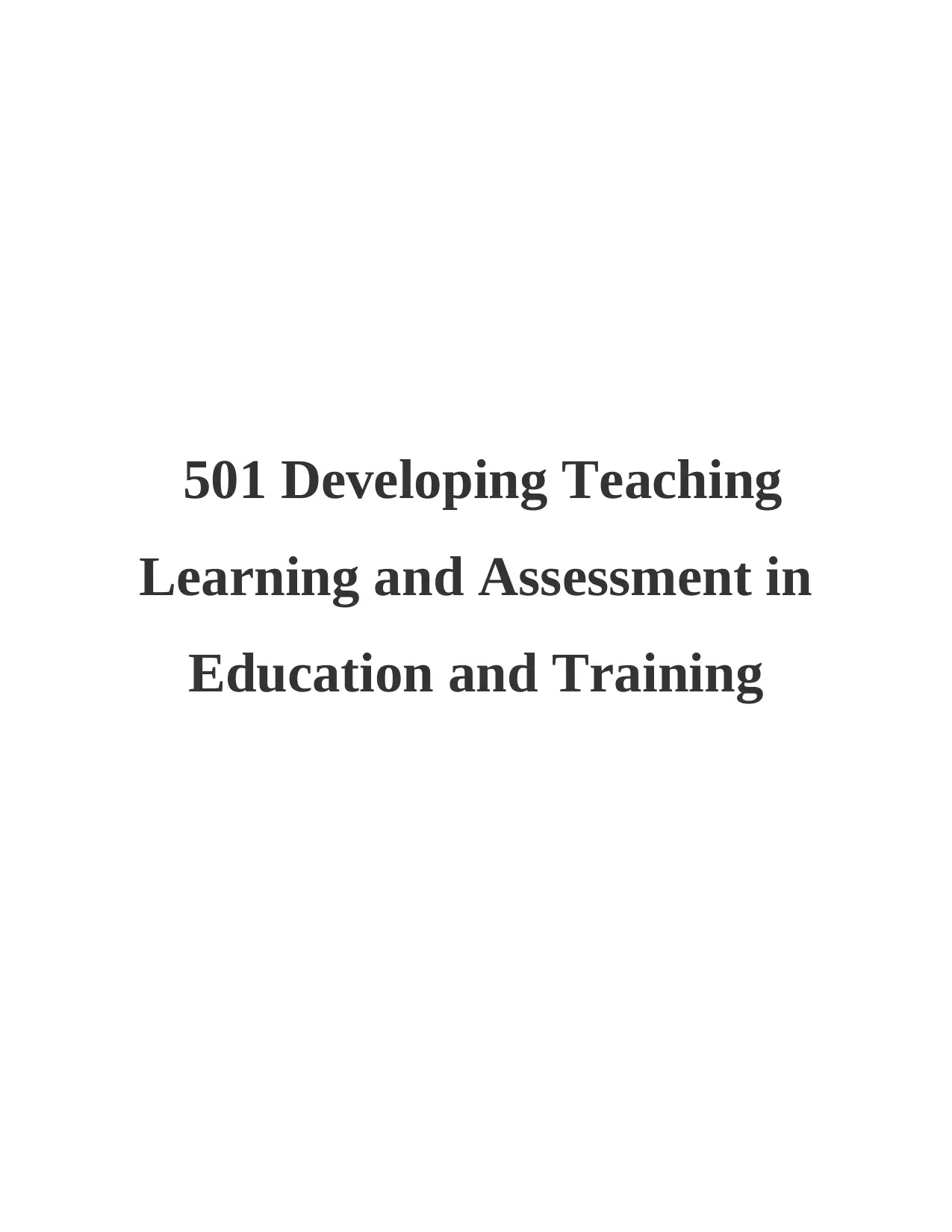
501 Developing Teaching
Learning and Assessment in
Education and Training
Learning and Assessment in
Education and Training
Paraphrase This Document
Need a fresh take? Get an instant paraphrase of this document with our AI Paraphraser
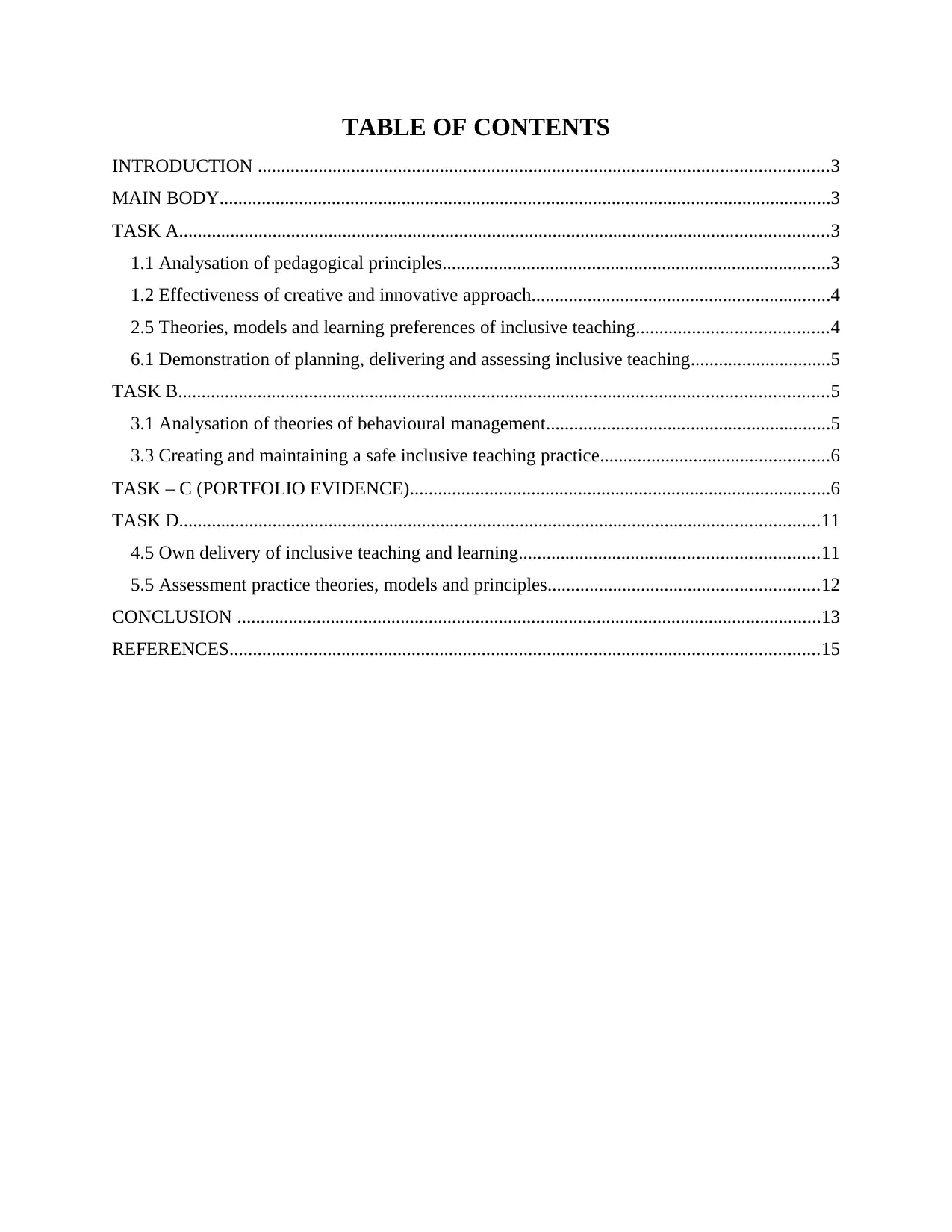
TABLE OF CONTENTS
INTRODUCTION ..........................................................................................................................3
MAIN BODY...................................................................................................................................3
TASK A...........................................................................................................................................3
1.1 Analysation of pedagogical principles...................................................................................3
1.2 Effectiveness of creative and innovative approach................................................................4
2.5 Theories, models and learning preferences of inclusive teaching.........................................4
6.1 Demonstration of planning, delivering and assessing inclusive teaching..............................5
TASK B...........................................................................................................................................5
3.1 Analysation of theories of behavioural management.............................................................5
3.3 Creating and maintaining a safe inclusive teaching practice.................................................6
TASK – C (PORTFOLIO EVIDENCE)..........................................................................................6
TASK D.........................................................................................................................................11
4.5 Own delivery of inclusive teaching and learning................................................................11
5.5 Assessment practice theories, models and principles..........................................................12
CONCLUSION .............................................................................................................................13
REFERENCES..............................................................................................................................15
INTRODUCTION ..........................................................................................................................3
MAIN BODY...................................................................................................................................3
TASK A...........................................................................................................................................3
1.1 Analysation of pedagogical principles...................................................................................3
1.2 Effectiveness of creative and innovative approach................................................................4
2.5 Theories, models and learning preferences of inclusive teaching.........................................4
6.1 Demonstration of planning, delivering and assessing inclusive teaching..............................5
TASK B...........................................................................................................................................5
3.1 Analysation of theories of behavioural management.............................................................5
3.3 Creating and maintaining a safe inclusive teaching practice.................................................6
TASK – C (PORTFOLIO EVIDENCE)..........................................................................................6
TASK D.........................................................................................................................................11
4.5 Own delivery of inclusive teaching and learning................................................................11
5.5 Assessment practice theories, models and principles..........................................................12
CONCLUSION .............................................................................................................................13
REFERENCES..............................................................................................................................15
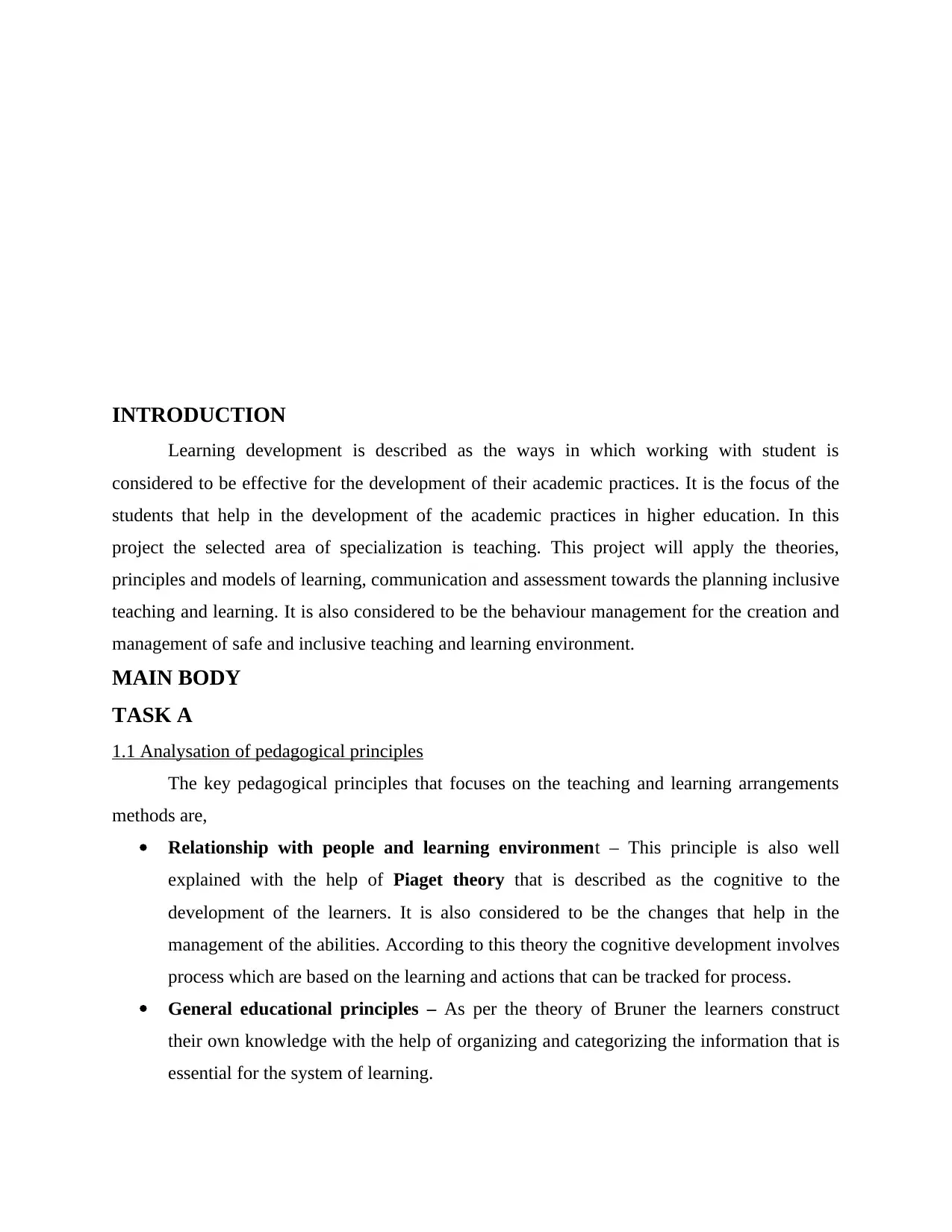
INTRODUCTION
Learning development is described as the ways in which working with student is
considered to be effective for the development of their academic practices. It is the focus of the
students that help in the development of the academic practices in higher education. In this
project the selected area of specialization is teaching. This project will apply the theories,
principles and models of learning, communication and assessment towards the planning inclusive
teaching and learning. It is also considered to be the behaviour management for the creation and
management of safe and inclusive teaching and learning environment.
MAIN BODY
TASK A
1.1 Analysation of pedagogical principles
The key pedagogical principles that focuses on the teaching and learning arrangements
methods are,
Relationship with people and learning environment – This principle is also well
explained with the help of Piaget theory that is described as the cognitive to the
development of the learners. It is also considered to be the changes that help in the
management of the abilities. According to this theory the cognitive development involves
process which are based on the learning and actions that can be tracked for process.
General educational principles – As per the theory of Bruner the learners construct
their own knowledge with the help of organizing and categorizing the information that is
essential for the system of learning.
Learning development is described as the ways in which working with student is
considered to be effective for the development of their academic practices. It is the focus of the
students that help in the development of the academic practices in higher education. In this
project the selected area of specialization is teaching. This project will apply the theories,
principles and models of learning, communication and assessment towards the planning inclusive
teaching and learning. It is also considered to be the behaviour management for the creation and
management of safe and inclusive teaching and learning environment.
MAIN BODY
TASK A
1.1 Analysation of pedagogical principles
The key pedagogical principles that focuses on the teaching and learning arrangements
methods are,
Relationship with people and learning environment – This principle is also well
explained with the help of Piaget theory that is described as the cognitive to the
development of the learners. It is also considered to be the changes that help in the
management of the abilities. According to this theory the cognitive development involves
process which are based on the learning and actions that can be tracked for process.
General educational principles – As per the theory of Bruner the learners construct
their own knowledge with the help of organizing and categorizing the information that is
essential for the system of learning.
⊘ This is a preview!⊘
Do you want full access?
Subscribe today to unlock all pages.

Trusted by 1+ million students worldwide
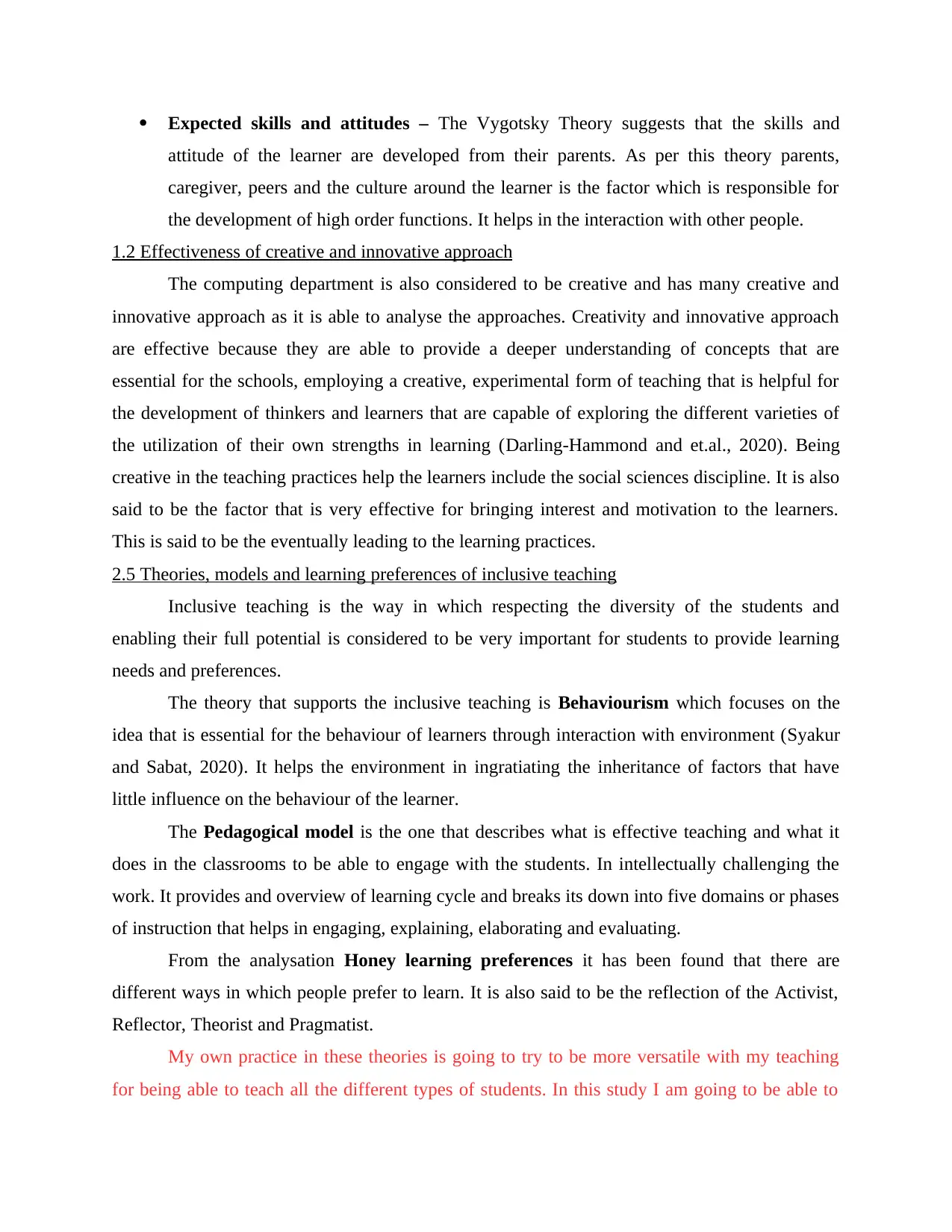
Expected skills and attitudes – The Vygotsky Theory suggests that the skills and
attitude of the learner are developed from their parents. As per this theory parents,
caregiver, peers and the culture around the learner is the factor which is responsible for
the development of high order functions. It helps in the interaction with other people.
1.2 Effectiveness of creative and innovative approach
The computing department is also considered to be creative and has many creative and
innovative approach as it is able to analyse the approaches. Creativity and innovative approach
are effective because they are able to provide a deeper understanding of concepts that are
essential for the schools, employing a creative, experimental form of teaching that is helpful for
the development of thinkers and learners that are capable of exploring the different varieties of
the utilization of their own strengths in learning (Darling-Hammond and et.al., 2020). Being
creative in the teaching practices help the learners include the social sciences discipline. It is also
said to be the factor that is very effective for bringing interest and motivation to the learners.
This is said to be the eventually leading to the learning practices.
2.5 Theories, models and learning preferences of inclusive teaching
Inclusive teaching is the way in which respecting the diversity of the students and
enabling their full potential is considered to be very important for students to provide learning
needs and preferences.
The theory that supports the inclusive teaching is Behaviourism which focuses on the
idea that is essential for the behaviour of learners through interaction with environment (Syakur
and Sabat, 2020). It helps the environment in ingratiating the inheritance of factors that have
little influence on the behaviour of the learner.
The Pedagogical model is the one that describes what is effective teaching and what it
does in the classrooms to be able to engage with the students. In intellectually challenging the
work. It provides and overview of learning cycle and breaks its down into five domains or phases
of instruction that helps in engaging, explaining, elaborating and evaluating.
From the analysation Honey learning preferences it has been found that there are
different ways in which people prefer to learn. It is also said to be the reflection of the Activist,
Reflector, Theorist and Pragmatist.
My own practice in these theories is going to try to be more versatile with my teaching
for being able to teach all the different types of students. In this study I am going to be able to
attitude of the learner are developed from their parents. As per this theory parents,
caregiver, peers and the culture around the learner is the factor which is responsible for
the development of high order functions. It helps in the interaction with other people.
1.2 Effectiveness of creative and innovative approach
The computing department is also considered to be creative and has many creative and
innovative approach as it is able to analyse the approaches. Creativity and innovative approach
are effective because they are able to provide a deeper understanding of concepts that are
essential for the schools, employing a creative, experimental form of teaching that is helpful for
the development of thinkers and learners that are capable of exploring the different varieties of
the utilization of their own strengths in learning (Darling-Hammond and et.al., 2020). Being
creative in the teaching practices help the learners include the social sciences discipline. It is also
said to be the factor that is very effective for bringing interest and motivation to the learners.
This is said to be the eventually leading to the learning practices.
2.5 Theories, models and learning preferences of inclusive teaching
Inclusive teaching is the way in which respecting the diversity of the students and
enabling their full potential is considered to be very important for students to provide learning
needs and preferences.
The theory that supports the inclusive teaching is Behaviourism which focuses on the
idea that is essential for the behaviour of learners through interaction with environment (Syakur
and Sabat, 2020). It helps the environment in ingratiating the inheritance of factors that have
little influence on the behaviour of the learner.
The Pedagogical model is the one that describes what is effective teaching and what it
does in the classrooms to be able to engage with the students. In intellectually challenging the
work. It provides and overview of learning cycle and breaks its down into five domains or phases
of instruction that helps in engaging, explaining, elaborating and evaluating.
From the analysation Honey learning preferences it has been found that there are
different ways in which people prefer to learn. It is also said to be the reflection of the Activist,
Reflector, Theorist and Pragmatist.
My own practice in these theories is going to try to be more versatile with my teaching
for being able to teach all the different types of students. In this study I am going to be able to
Paraphrase This Document
Need a fresh take? Get an instant paraphrase of this document with our AI Paraphraser
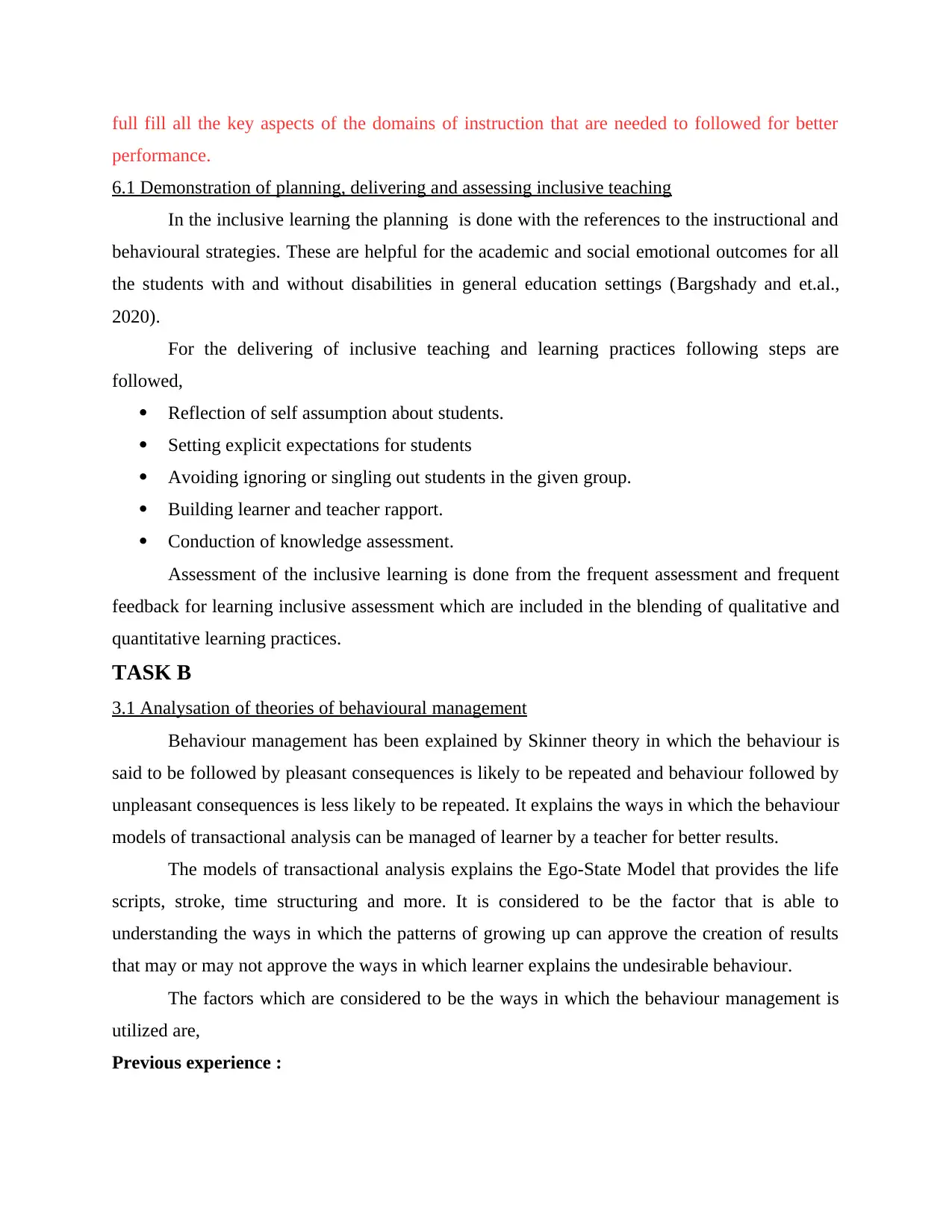
full fill all the key aspects of the domains of instruction that are needed to followed for better
performance.
6.1 Demonstration of planning, delivering and assessing inclusive teaching
In the inclusive learning the planning is done with the references to the instructional and
behavioural strategies. These are helpful for the academic and social emotional outcomes for all
the students with and without disabilities in general education settings (Bargshady and et.al.,
2020).
For the delivering of inclusive teaching and learning practices following steps are
followed,
Reflection of self assumption about students.
Setting explicit expectations for students
Avoiding ignoring or singling out students in the given group.
Building learner and teacher rapport.
Conduction of knowledge assessment.
Assessment of the inclusive learning is done from the frequent assessment and frequent
feedback for learning inclusive assessment which are included in the blending of qualitative and
quantitative learning practices.
TASK B
3.1 Analysation of theories of behavioural management
Behaviour management has been explained by Skinner theory in which the behaviour is
said to be followed by pleasant consequences is likely to be repeated and behaviour followed by
unpleasant consequences is less likely to be repeated. It explains the ways in which the behaviour
models of transactional analysis can be managed of learner by a teacher for better results.
The models of transactional analysis explains the Ego-State Model that provides the life
scripts, stroke, time structuring and more. It is considered to be the factor that is able to
understanding the ways in which the patterns of growing up can approve the creation of results
that may or may not approve the ways in which learner explains the undesirable behaviour.
The factors which are considered to be the ways in which the behaviour management is
utilized are,
Previous experience :
performance.
6.1 Demonstration of planning, delivering and assessing inclusive teaching
In the inclusive learning the planning is done with the references to the instructional and
behavioural strategies. These are helpful for the academic and social emotional outcomes for all
the students with and without disabilities in general education settings (Bargshady and et.al.,
2020).
For the delivering of inclusive teaching and learning practices following steps are
followed,
Reflection of self assumption about students.
Setting explicit expectations for students
Avoiding ignoring or singling out students in the given group.
Building learner and teacher rapport.
Conduction of knowledge assessment.
Assessment of the inclusive learning is done from the frequent assessment and frequent
feedback for learning inclusive assessment which are included in the blending of qualitative and
quantitative learning practices.
TASK B
3.1 Analysation of theories of behavioural management
Behaviour management has been explained by Skinner theory in which the behaviour is
said to be followed by pleasant consequences is likely to be repeated and behaviour followed by
unpleasant consequences is less likely to be repeated. It explains the ways in which the behaviour
models of transactional analysis can be managed of learner by a teacher for better results.
The models of transactional analysis explains the Ego-State Model that provides the life
scripts, stroke, time structuring and more. It is considered to be the factor that is able to
understanding the ways in which the patterns of growing up can approve the creation of results
that may or may not approve the ways in which learner explains the undesirable behaviour.
The factors which are considered to be the ways in which the behaviour management is
utilized are,
Previous experience :
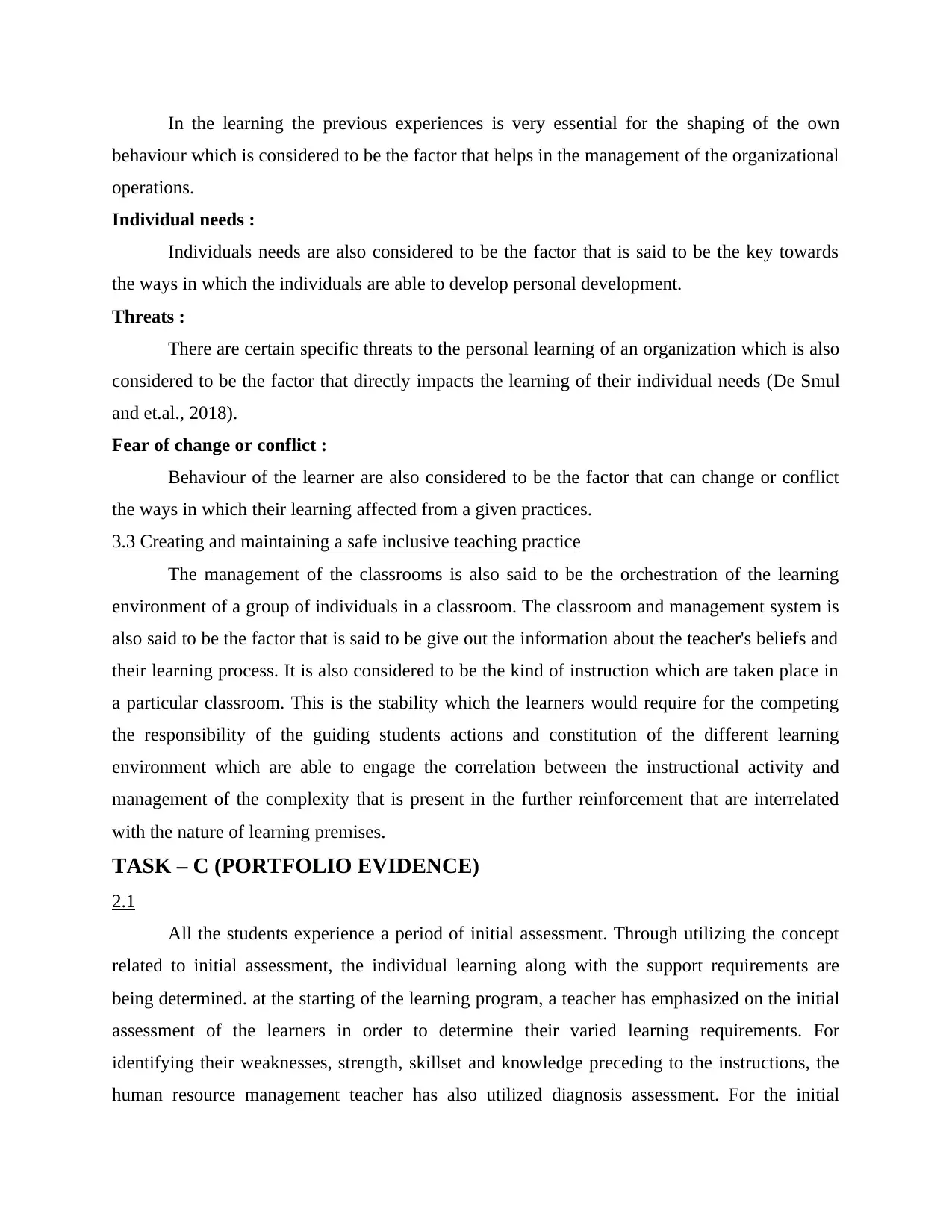
In the learning the previous experiences is very essential for the shaping of the own
behaviour which is considered to be the factor that helps in the management of the organizational
operations.
Individual needs :
Individuals needs are also considered to be the factor that is said to be the key towards
the ways in which the individuals are able to develop personal development.
Threats :
There are certain specific threats to the personal learning of an organization which is also
considered to be the factor that directly impacts the learning of their individual needs (De Smul
and et.al., 2018).
Fear of change or conflict :
Behaviour of the learner are also considered to be the factor that can change or conflict
the ways in which their learning affected from a given practices.
3.3 Creating and maintaining a safe inclusive teaching practice
The management of the classrooms is also said to be the orchestration of the learning
environment of a group of individuals in a classroom. The classroom and management system is
also said to be the factor that is said to be give out the information about the teacher's beliefs and
their learning process. It is also considered to be the kind of instruction which are taken place in
a particular classroom. This is the stability which the learners would require for the competing
the responsibility of the guiding students actions and constitution of the different learning
environment which are able to engage the correlation between the instructional activity and
management of the complexity that is present in the further reinforcement that are interrelated
with the nature of learning premises.
TASK – C (PORTFOLIO EVIDENCE)
2.1
All the students experience a period of initial assessment. Through utilizing the concept
related to initial assessment, the individual learning along with the support requirements are
being determined. at the starting of the learning program, a teacher has emphasized on the initial
assessment of the learners in order to determine their varied learning requirements. For
identifying their weaknesses, strength, skillset and knowledge preceding to the instructions, the
human resource management teacher has also utilized diagnosis assessment. For the initial
behaviour which is considered to be the factor that helps in the management of the organizational
operations.
Individual needs :
Individuals needs are also considered to be the factor that is said to be the key towards
the ways in which the individuals are able to develop personal development.
Threats :
There are certain specific threats to the personal learning of an organization which is also
considered to be the factor that directly impacts the learning of their individual needs (De Smul
and et.al., 2018).
Fear of change or conflict :
Behaviour of the learner are also considered to be the factor that can change or conflict
the ways in which their learning affected from a given practices.
3.3 Creating and maintaining a safe inclusive teaching practice
The management of the classrooms is also said to be the orchestration of the learning
environment of a group of individuals in a classroom. The classroom and management system is
also said to be the factor that is said to be give out the information about the teacher's beliefs and
their learning process. It is also considered to be the kind of instruction which are taken place in
a particular classroom. This is the stability which the learners would require for the competing
the responsibility of the guiding students actions and constitution of the different learning
environment which are able to engage the correlation between the instructional activity and
management of the complexity that is present in the further reinforcement that are interrelated
with the nature of learning premises.
TASK – C (PORTFOLIO EVIDENCE)
2.1
All the students experience a period of initial assessment. Through utilizing the concept
related to initial assessment, the individual learning along with the support requirements are
being determined. at the starting of the learning program, a teacher has emphasized on the initial
assessment of the learners in order to determine their varied learning requirements. For
identifying their weaknesses, strength, skillset and knowledge preceding to the instructions, the
human resource management teacher has also utilized diagnosis assessment. For the initial
⊘ This is a preview!⊘
Do you want full access?
Subscribe today to unlock all pages.

Trusted by 1+ million students worldwide
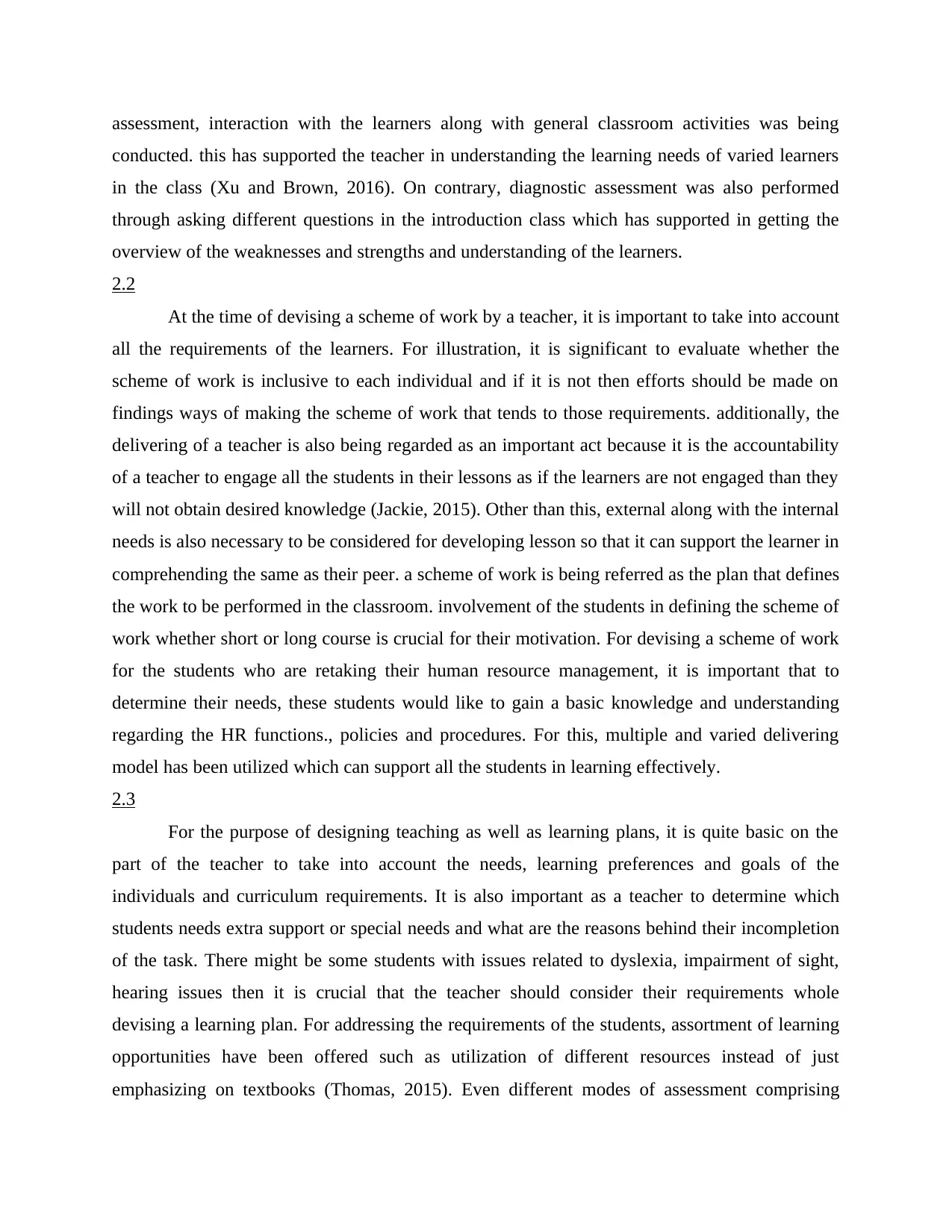
assessment, interaction with the learners along with general classroom activities was being
conducted. this has supported the teacher in understanding the learning needs of varied learners
in the class (Xu and Brown, 2016). On contrary, diagnostic assessment was also performed
through asking different questions in the introduction class which has supported in getting the
overview of the weaknesses and strengths and understanding of the learners.
2.2
At the time of devising a scheme of work by a teacher, it is important to take into account
all the requirements of the learners. For illustration, it is significant to evaluate whether the
scheme of work is inclusive to each individual and if it is not then efforts should be made on
findings ways of making the scheme of work that tends to those requirements. additionally, the
delivering of a teacher is also being regarded as an important act because it is the accountability
of a teacher to engage all the students in their lessons as if the learners are not engaged than they
will not obtain desired knowledge (Jackie, 2015). Other than this, external along with the internal
needs is also necessary to be considered for developing lesson so that it can support the learner in
comprehending the same as their peer. a scheme of work is being referred as the plan that defines
the work to be performed in the classroom. involvement of the students in defining the scheme of
work whether short or long course is crucial for their motivation. For devising a scheme of work
for the students who are retaking their human resource management, it is important that to
determine their needs, these students would like to gain a basic knowledge and understanding
regarding the HR functions., policies and procedures. For this, multiple and varied delivering
model has been utilized which can support all the students in learning effectively.
2.3
For the purpose of designing teaching as well as learning plans, it is quite basic on the
part of the teacher to take into account the needs, learning preferences and goals of the
individuals and curriculum requirements. It is also important as a teacher to determine which
students needs extra support or special needs and what are the reasons behind their incompletion
of the task. There might be some students with issues related to dyslexia, impairment of sight,
hearing issues then it is crucial that the teacher should consider their requirements whole
devising a learning plan. For addressing the requirements of the students, assortment of learning
opportunities have been offered such as utilization of different resources instead of just
emphasizing on textbooks (Thomas, 2015). Even different modes of assessment comprising
conducted. this has supported the teacher in understanding the learning needs of varied learners
in the class (Xu and Brown, 2016). On contrary, diagnostic assessment was also performed
through asking different questions in the introduction class which has supported in getting the
overview of the weaknesses and strengths and understanding of the learners.
2.2
At the time of devising a scheme of work by a teacher, it is important to take into account
all the requirements of the learners. For illustration, it is significant to evaluate whether the
scheme of work is inclusive to each individual and if it is not then efforts should be made on
findings ways of making the scheme of work that tends to those requirements. additionally, the
delivering of a teacher is also being regarded as an important act because it is the accountability
of a teacher to engage all the students in their lessons as if the learners are not engaged than they
will not obtain desired knowledge (Jackie, 2015). Other than this, external along with the internal
needs is also necessary to be considered for developing lesson so that it can support the learner in
comprehending the same as their peer. a scheme of work is being referred as the plan that defines
the work to be performed in the classroom. involvement of the students in defining the scheme of
work whether short or long course is crucial for their motivation. For devising a scheme of work
for the students who are retaking their human resource management, it is important that to
determine their needs, these students would like to gain a basic knowledge and understanding
regarding the HR functions., policies and procedures. For this, multiple and varied delivering
model has been utilized which can support all the students in learning effectively.
2.3
For the purpose of designing teaching as well as learning plans, it is quite basic on the
part of the teacher to take into account the needs, learning preferences and goals of the
individuals and curriculum requirements. It is also important as a teacher to determine which
students needs extra support or special needs and what are the reasons behind their incompletion
of the task. There might be some students with issues related to dyslexia, impairment of sight,
hearing issues then it is crucial that the teacher should consider their requirements whole
devising a learning plan. For addressing the requirements of the students, assortment of learning
opportunities have been offered such as utilization of different resources instead of just
emphasizing on textbooks (Thomas, 2015). Even different modes of assessment comprising
Paraphrase This Document
Need a fresh take? Get an instant paraphrase of this document with our AI Paraphraser
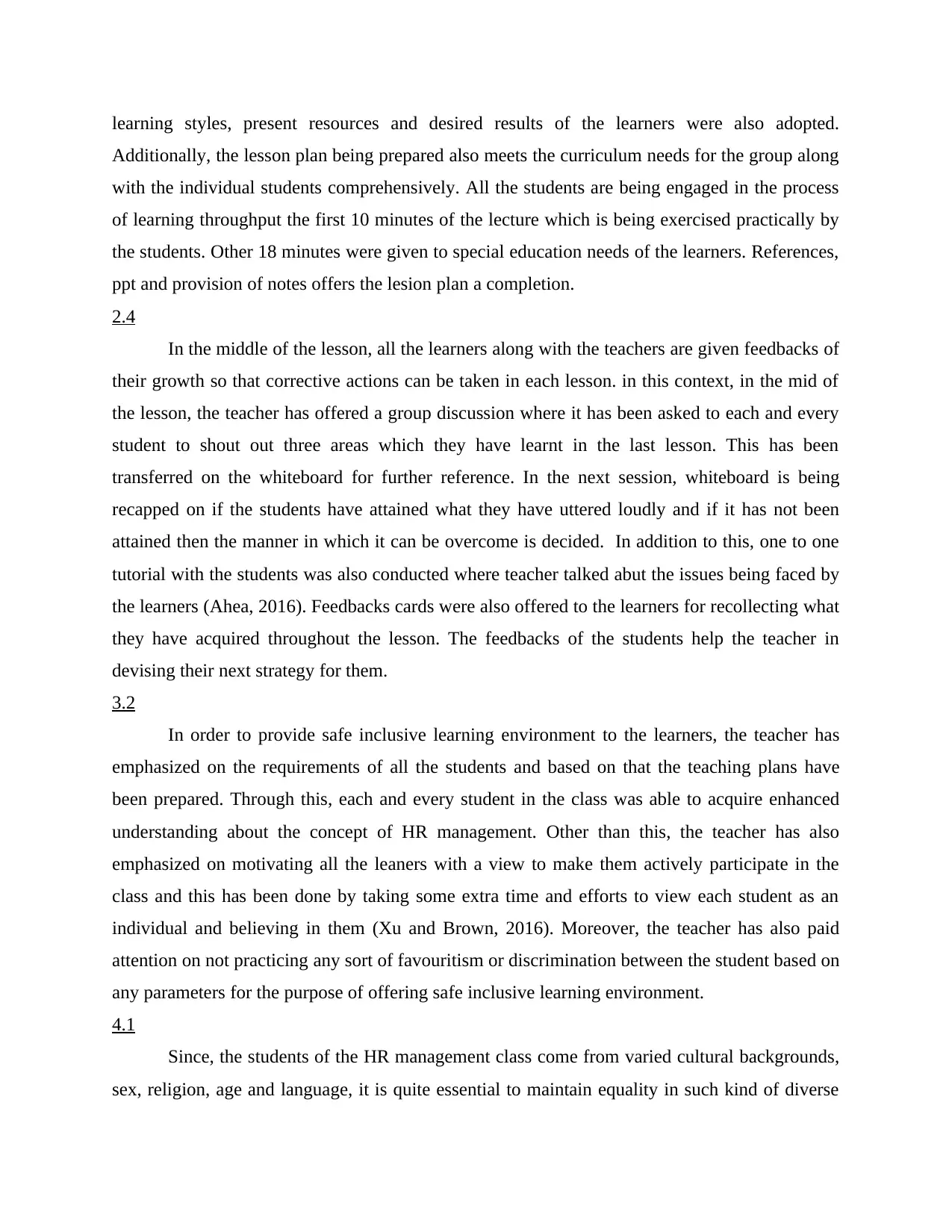
learning styles, present resources and desired results of the learners were also adopted.
Additionally, the lesson plan being prepared also meets the curriculum needs for the group along
with the individual students comprehensively. All the students are being engaged in the process
of learning throughput the first 10 minutes of the lecture which is being exercised practically by
the students. Other 18 minutes were given to special education needs of the learners. References,
ppt and provision of notes offers the lesion plan a completion.
2.4
In the middle of the lesson, all the learners along with the teachers are given feedbacks of
their growth so that corrective actions can be taken in each lesson. in this context, in the mid of
the lesson, the teacher has offered a group discussion where it has been asked to each and every
student to shout out three areas which they have learnt in the last lesson. This has been
transferred on the whiteboard for further reference. In the next session, whiteboard is being
recapped on if the students have attained what they have uttered loudly and if it has not been
attained then the manner in which it can be overcome is decided. In addition to this, one to one
tutorial with the students was also conducted where teacher talked abut the issues being faced by
the learners (Ahea, 2016). Feedbacks cards were also offered to the learners for recollecting what
they have acquired throughout the lesson. The feedbacks of the students help the teacher in
devising their next strategy for them.
3.2
In order to provide safe inclusive learning environment to the learners, the teacher has
emphasized on the requirements of all the students and based on that the teaching plans have
been prepared. Through this, each and every student in the class was able to acquire enhanced
understanding about the concept of HR management. Other than this, the teacher has also
emphasized on motivating all the leaners with a view to make them actively participate in the
class and this has been done by taking some extra time and efforts to view each student as an
individual and believing in them (Xu and Brown, 2016). Moreover, the teacher has also paid
attention on not practicing any sort of favouritism or discrimination between the student based on
any parameters for the purpose of offering safe inclusive learning environment.
4.1
Since, the students of the HR management class come from varied cultural backgrounds,
sex, religion, age and language, it is quite essential to maintain equality in such kind of diverse
Additionally, the lesson plan being prepared also meets the curriculum needs for the group along
with the individual students comprehensively. All the students are being engaged in the process
of learning throughput the first 10 minutes of the lecture which is being exercised practically by
the students. Other 18 minutes were given to special education needs of the learners. References,
ppt and provision of notes offers the lesion plan a completion.
2.4
In the middle of the lesson, all the learners along with the teachers are given feedbacks of
their growth so that corrective actions can be taken in each lesson. in this context, in the mid of
the lesson, the teacher has offered a group discussion where it has been asked to each and every
student to shout out three areas which they have learnt in the last lesson. This has been
transferred on the whiteboard for further reference. In the next session, whiteboard is being
recapped on if the students have attained what they have uttered loudly and if it has not been
attained then the manner in which it can be overcome is decided. In addition to this, one to one
tutorial with the students was also conducted where teacher talked abut the issues being faced by
the learners (Ahea, 2016). Feedbacks cards were also offered to the learners for recollecting what
they have acquired throughout the lesson. The feedbacks of the students help the teacher in
devising their next strategy for them.
3.2
In order to provide safe inclusive learning environment to the learners, the teacher has
emphasized on the requirements of all the students and based on that the teaching plans have
been prepared. Through this, each and every student in the class was able to acquire enhanced
understanding about the concept of HR management. Other than this, the teacher has also
emphasized on motivating all the leaners with a view to make them actively participate in the
class and this has been done by taking some extra time and efforts to view each student as an
individual and believing in them (Xu and Brown, 2016). Moreover, the teacher has also paid
attention on not practicing any sort of favouritism or discrimination between the student based on
any parameters for the purpose of offering safe inclusive learning environment.
4.1
Since, the students of the HR management class come from varied cultural backgrounds,
sex, religion, age and language, it is quite essential to maintain equality in such kind of diverse
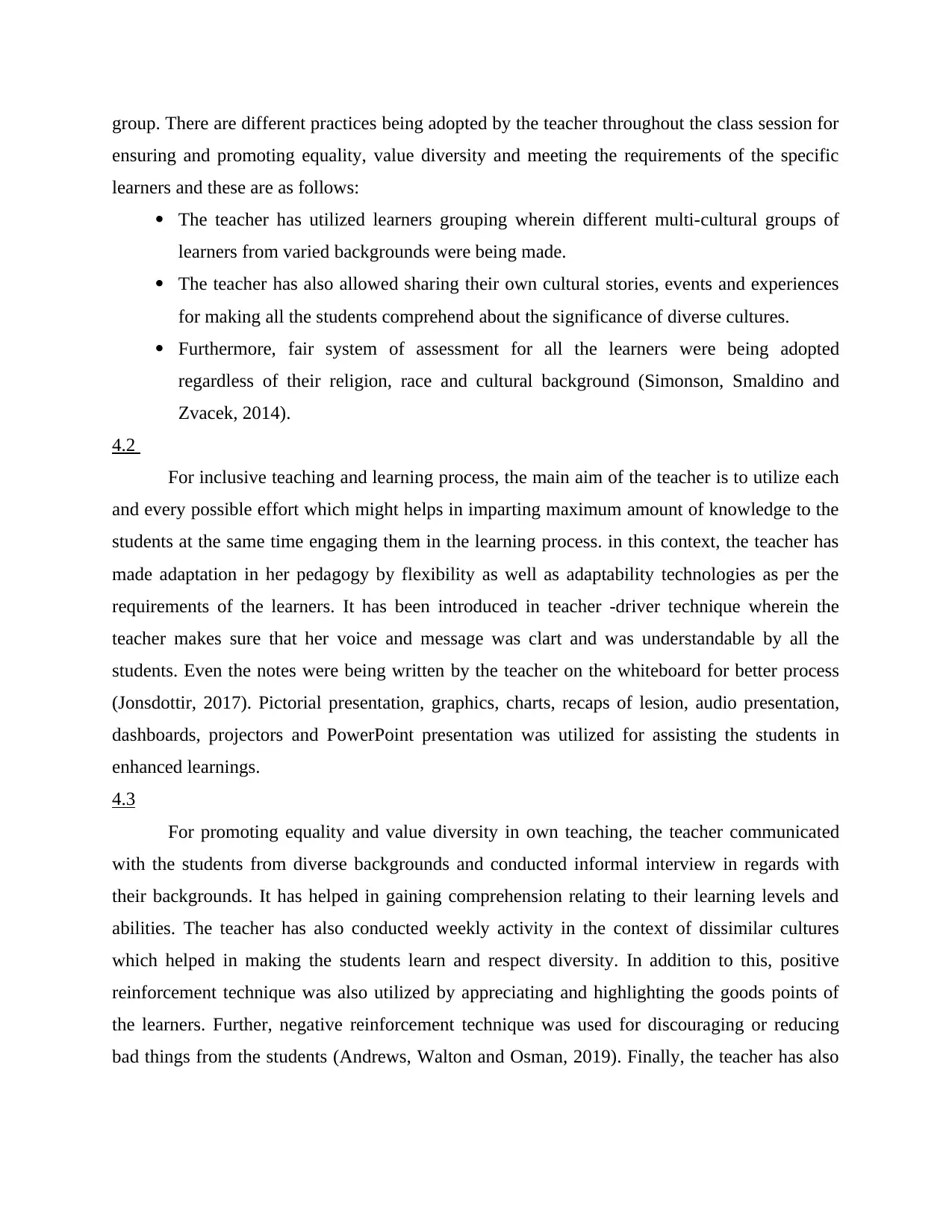
group. There are different practices being adopted by the teacher throughout the class session for
ensuring and promoting equality, value diversity and meeting the requirements of the specific
learners and these are as follows:
The teacher has utilized learners grouping wherein different multi-cultural groups of
learners from varied backgrounds were being made.
The teacher has also allowed sharing their own cultural stories, events and experiences
for making all the students comprehend about the significance of diverse cultures.
Furthermore, fair system of assessment for all the learners were being adopted
regardless of their religion, race and cultural background (Simonson, Smaldino and
Zvacek, 2014).
4.2
For inclusive teaching and learning process, the main aim of the teacher is to utilize each
and every possible effort which might helps in imparting maximum amount of knowledge to the
students at the same time engaging them in the learning process. in this context, the teacher has
made adaptation in her pedagogy by flexibility as well as adaptability technologies as per the
requirements of the learners. It has been introduced in teacher -driver technique wherein the
teacher makes sure that her voice and message was clart and was understandable by all the
students. Even the notes were being written by the teacher on the whiteboard for better process
(Jonsdottir, 2017). Pictorial presentation, graphics, charts, recaps of lesion, audio presentation,
dashboards, projectors and PowerPoint presentation was utilized for assisting the students in
enhanced learnings.
4.3
For promoting equality and value diversity in own teaching, the teacher communicated
with the students from diverse backgrounds and conducted informal interview in regards with
their backgrounds. It has helped in gaining comprehension relating to their learning levels and
abilities. The teacher has also conducted weekly activity in the context of dissimilar cultures
which helped in making the students learn and respect diversity. In addition to this, positive
reinforcement technique was also utilized by appreciating and highlighting the goods points of
the learners. Further, negative reinforcement technique was used for discouraging or reducing
bad things from the students (Andrews, Walton and Osman, 2019). Finally, the teacher has also
ensuring and promoting equality, value diversity and meeting the requirements of the specific
learners and these are as follows:
The teacher has utilized learners grouping wherein different multi-cultural groups of
learners from varied backgrounds were being made.
The teacher has also allowed sharing their own cultural stories, events and experiences
for making all the students comprehend about the significance of diverse cultures.
Furthermore, fair system of assessment for all the learners were being adopted
regardless of their religion, race and cultural background (Simonson, Smaldino and
Zvacek, 2014).
4.2
For inclusive teaching and learning process, the main aim of the teacher is to utilize each
and every possible effort which might helps in imparting maximum amount of knowledge to the
students at the same time engaging them in the learning process. in this context, the teacher has
made adaptation in her pedagogy by flexibility as well as adaptability technologies as per the
requirements of the learners. It has been introduced in teacher -driver technique wherein the
teacher makes sure that her voice and message was clart and was understandable by all the
students. Even the notes were being written by the teacher on the whiteboard for better process
(Jonsdottir, 2017). Pictorial presentation, graphics, charts, recaps of lesion, audio presentation,
dashboards, projectors and PowerPoint presentation was utilized for assisting the students in
enhanced learnings.
4.3
For promoting equality and value diversity in own teaching, the teacher communicated
with the students from diverse backgrounds and conducted informal interview in regards with
their backgrounds. It has helped in gaining comprehension relating to their learning levels and
abilities. The teacher has also conducted weekly activity in the context of dissimilar cultures
which helped in making the students learn and respect diversity. In addition to this, positive
reinforcement technique was also utilized by appreciating and highlighting the goods points of
the learners. Further, negative reinforcement technique was used for discouraging or reducing
bad things from the students (Andrews, Walton and Osman, 2019). Finally, the teacher has also
⊘ This is a preview!⊘
Do you want full access?
Subscribe today to unlock all pages.

Trusted by 1+ million students worldwide
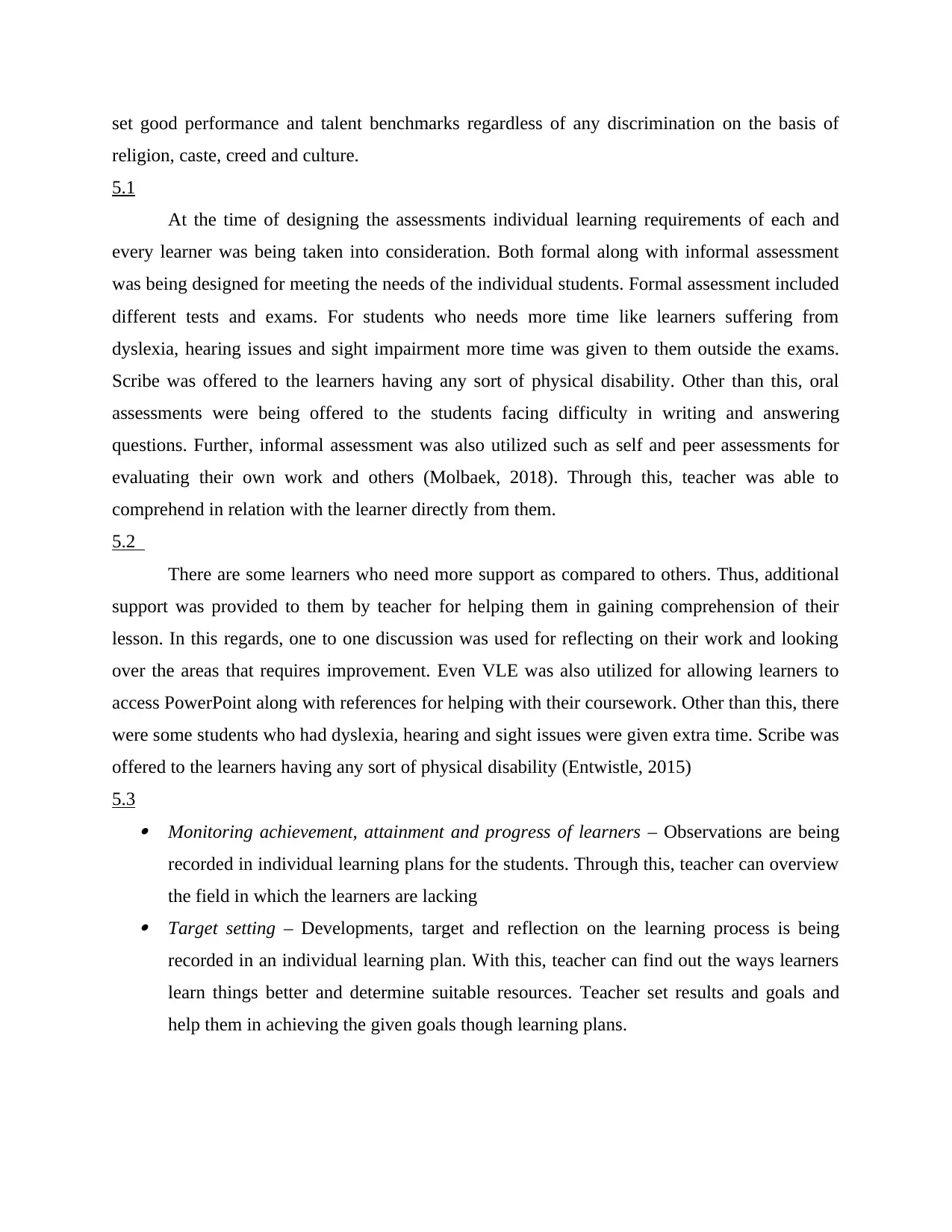
set good performance and talent benchmarks regardless of any discrimination on the basis of
religion, caste, creed and culture.
5.1
At the time of designing the assessments individual learning requirements of each and
every learner was being taken into consideration. Both formal along with informal assessment
was being designed for meeting the needs of the individual students. Formal assessment included
different tests and exams. For students who needs more time like learners suffering from
dyslexia, hearing issues and sight impairment more time was given to them outside the exams.
Scribe was offered to the learners having any sort of physical disability. Other than this, oral
assessments were being offered to the students facing difficulty in writing and answering
questions. Further, informal assessment was also utilized such as self and peer assessments for
evaluating their own work and others (Molbaek, 2018). Through this, teacher was able to
comprehend in relation with the learner directly from them.
5.2
There are some learners who need more support as compared to others. Thus, additional
support was provided to them by teacher for helping them in gaining comprehension of their
lesson. In this regards, one to one discussion was used for reflecting on their work and looking
over the areas that requires improvement. Even VLE was also utilized for allowing learners to
access PowerPoint along with references for helping with their coursework. Other than this, there
were some students who had dyslexia, hearing and sight issues were given extra time. Scribe was
offered to the learners having any sort of physical disability (Entwistle, 2015)
5.3 Monitoring achievement, attainment and progress of learners – Observations are being
recorded in individual learning plans for the students. Through this, teacher can overview
the field in which the learners are lacking Target setting – Developments, target and reflection on the learning process is being
recorded in an individual learning plan. With this, teacher can find out the ways learners
learn things better and determine suitable resources. Teacher set results and goals and
help them in achieving the given goals though learning plans.
religion, caste, creed and culture.
5.1
At the time of designing the assessments individual learning requirements of each and
every learner was being taken into consideration. Both formal along with informal assessment
was being designed for meeting the needs of the individual students. Formal assessment included
different tests and exams. For students who needs more time like learners suffering from
dyslexia, hearing issues and sight impairment more time was given to them outside the exams.
Scribe was offered to the learners having any sort of physical disability. Other than this, oral
assessments were being offered to the students facing difficulty in writing and answering
questions. Further, informal assessment was also utilized such as self and peer assessments for
evaluating their own work and others (Molbaek, 2018). Through this, teacher was able to
comprehend in relation with the learner directly from them.
5.2
There are some learners who need more support as compared to others. Thus, additional
support was provided to them by teacher for helping them in gaining comprehension of their
lesson. In this regards, one to one discussion was used for reflecting on their work and looking
over the areas that requires improvement. Even VLE was also utilized for allowing learners to
access PowerPoint along with references for helping with their coursework. Other than this, there
were some students who had dyslexia, hearing and sight issues were given extra time. Scribe was
offered to the learners having any sort of physical disability (Entwistle, 2015)
5.3 Monitoring achievement, attainment and progress of learners – Observations are being
recorded in individual learning plans for the students. Through this, teacher can overview
the field in which the learners are lacking Target setting – Developments, target and reflection on the learning process is being
recorded in an individual learning plan. With this, teacher can find out the ways learners
learn things better and determine suitable resources. Teacher set results and goals and
help them in achieving the given goals though learning plans.
Paraphrase This Document
Need a fresh take? Get an instant paraphrase of this document with our AI Paraphraser
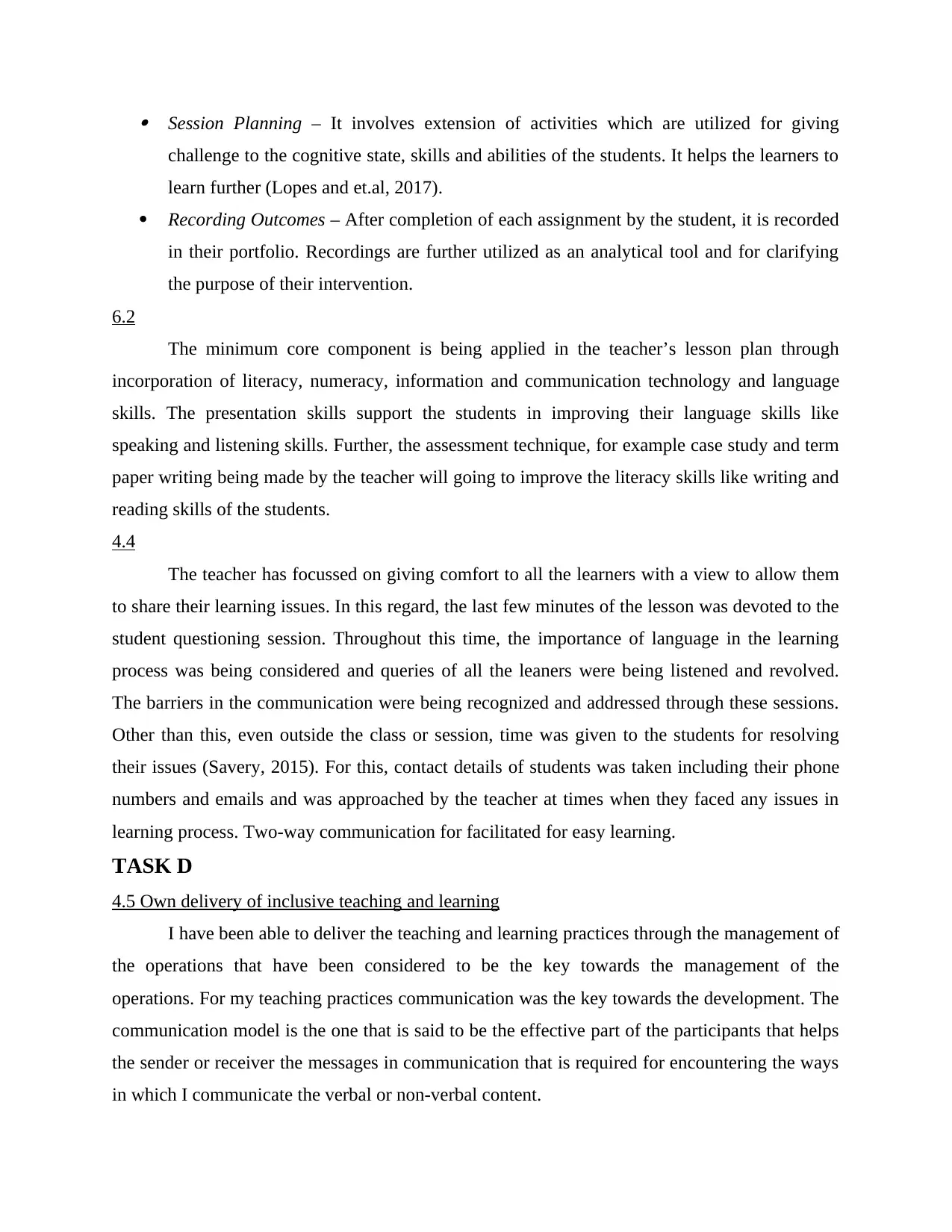
Session Planning – It involves extension of activities which are utilized for giving
challenge to the cognitive state, skills and abilities of the students. It helps the learners to
learn further (Lopes and et.al, 2017).
Recording Outcomes – After completion of each assignment by the student, it is recorded
in their portfolio. Recordings are further utilized as an analytical tool and for clarifying
the purpose of their intervention.
6.2
The minimum core component is being applied in the teacher’s lesson plan through
incorporation of literacy, numeracy, information and communication technology and language
skills. The presentation skills support the students in improving their language skills like
speaking and listening skills. Further, the assessment technique, for example case study and term
paper writing being made by the teacher will going to improve the literacy skills like writing and
reading skills of the students.
4.4
The teacher has focussed on giving comfort to all the learners with a view to allow them
to share their learning issues. In this regard, the last few minutes of the lesson was devoted to the
student questioning session. Throughout this time, the importance of language in the learning
process was being considered and queries of all the leaners were being listened and revolved.
The barriers in the communication were being recognized and addressed through these sessions.
Other than this, even outside the class or session, time was given to the students for resolving
their issues (Savery, 2015). For this, contact details of students was taken including their phone
numbers and emails and was approached by the teacher at times when they faced any issues in
learning process. Two-way communication for facilitated for easy learning.
TASK D
4.5 Own delivery of inclusive teaching and learning
I have been able to deliver the teaching and learning practices through the management of
the operations that have been considered to be the key towards the management of the
operations. For my teaching practices communication was the key towards the development. The
communication model is the one that is said to be the effective part of the participants that helps
the sender or receiver the messages in communication that is required for encountering the ways
in which I communicate the verbal or non-verbal content.
challenge to the cognitive state, skills and abilities of the students. It helps the learners to
learn further (Lopes and et.al, 2017).
Recording Outcomes – After completion of each assignment by the student, it is recorded
in their portfolio. Recordings are further utilized as an analytical tool and for clarifying
the purpose of their intervention.
6.2
The minimum core component is being applied in the teacher’s lesson plan through
incorporation of literacy, numeracy, information and communication technology and language
skills. The presentation skills support the students in improving their language skills like
speaking and listening skills. Further, the assessment technique, for example case study and term
paper writing being made by the teacher will going to improve the literacy skills like writing and
reading skills of the students.
4.4
The teacher has focussed on giving comfort to all the learners with a view to allow them
to share their learning issues. In this regard, the last few minutes of the lesson was devoted to the
student questioning session. Throughout this time, the importance of language in the learning
process was being considered and queries of all the leaners were being listened and revolved.
The barriers in the communication were being recognized and addressed through these sessions.
Other than this, even outside the class or session, time was given to the students for resolving
their issues (Savery, 2015). For this, contact details of students was taken including their phone
numbers and emails and was approached by the teacher at times when they faced any issues in
learning process. Two-way communication for facilitated for easy learning.
TASK D
4.5 Own delivery of inclusive teaching and learning
I have been able to deliver the teaching and learning practices through the management of
the operations that have been considered to be the key towards the management of the
operations. For my teaching practices communication was the key towards the development. The
communication model is the one that is said to be the effective part of the participants that helps
the sender or receiver the messages in communication that is required for encountering the ways
in which I communicate the verbal or non-verbal content.
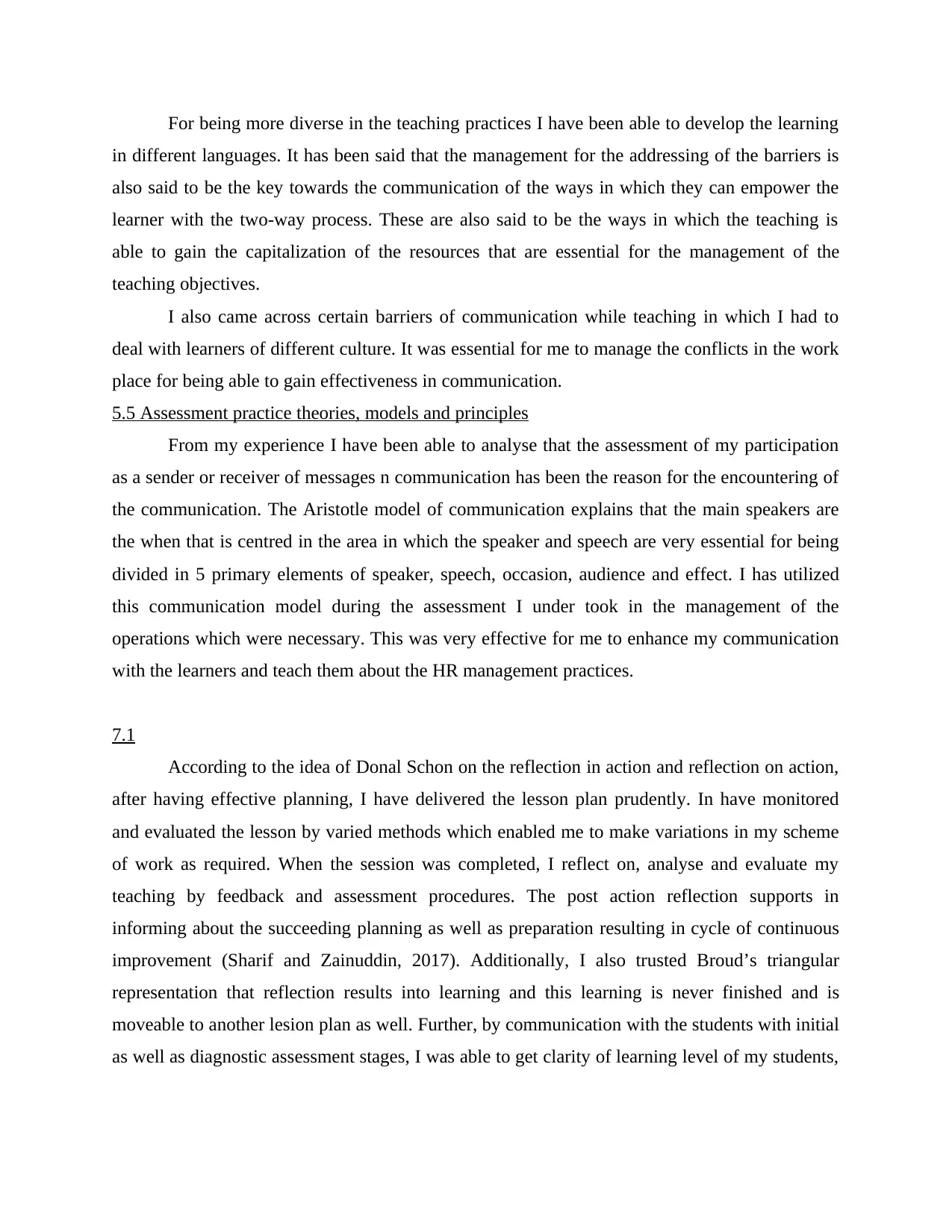
For being more diverse in the teaching practices I have been able to develop the learning
in different languages. It has been said that the management for the addressing of the barriers is
also said to be the key towards the communication of the ways in which they can empower the
learner with the two-way process. These are also said to be the ways in which the teaching is
able to gain the capitalization of the resources that are essential for the management of the
teaching objectives.
I also came across certain barriers of communication while teaching in which I had to
deal with learners of different culture. It was essential for me to manage the conflicts in the work
place for being able to gain effectiveness in communication.
5.5 Assessment practice theories, models and principles
From my experience I have been able to analyse that the assessment of my participation
as a sender or receiver of messages n communication has been the reason for the encountering of
the communication. The Aristotle model of communication explains that the main speakers are
the when that is centred in the area in which the speaker and speech are very essential for being
divided in 5 primary elements of speaker, speech, occasion, audience and effect. I has utilized
this communication model during the assessment I under took in the management of the
operations which were necessary. This was very effective for me to enhance my communication
with the learners and teach them about the HR management practices.
7.1
According to the idea of Donal Schon on the reflection in action and reflection on action,
after having effective planning, I have delivered the lesson plan prudently. In have monitored
and evaluated the lesson by varied methods which enabled me to make variations in my scheme
of work as required. When the session was completed, I reflect on, analyse and evaluate my
teaching by feedback and assessment procedures. The post action reflection supports in
informing about the succeeding planning as well as preparation resulting in cycle of continuous
improvement (Sharif and Zainuddin, 2017). Additionally, I also trusted Broud’s triangular
representation that reflection results into learning and this learning is never finished and is
moveable to another lesion plan as well. Further, by communication with the students with initial
as well as diagnostic assessment stages, I was able to get clarity of learning level of my students,
in different languages. It has been said that the management for the addressing of the barriers is
also said to be the key towards the communication of the ways in which they can empower the
learner with the two-way process. These are also said to be the ways in which the teaching is
able to gain the capitalization of the resources that are essential for the management of the
teaching objectives.
I also came across certain barriers of communication while teaching in which I had to
deal with learners of different culture. It was essential for me to manage the conflicts in the work
place for being able to gain effectiveness in communication.
5.5 Assessment practice theories, models and principles
From my experience I have been able to analyse that the assessment of my participation
as a sender or receiver of messages n communication has been the reason for the encountering of
the communication. The Aristotle model of communication explains that the main speakers are
the when that is centred in the area in which the speaker and speech are very essential for being
divided in 5 primary elements of speaker, speech, occasion, audience and effect. I has utilized
this communication model during the assessment I under took in the management of the
operations which were necessary. This was very effective for me to enhance my communication
with the learners and teach them about the HR management practices.
7.1
According to the idea of Donal Schon on the reflection in action and reflection on action,
after having effective planning, I have delivered the lesson plan prudently. In have monitored
and evaluated the lesson by varied methods which enabled me to make variations in my scheme
of work as required. When the session was completed, I reflect on, analyse and evaluate my
teaching by feedback and assessment procedures. The post action reflection supports in
informing about the succeeding planning as well as preparation resulting in cycle of continuous
improvement (Sharif and Zainuddin, 2017). Additionally, I also trusted Broud’s triangular
representation that reflection results into learning and this learning is never finished and is
moveable to another lesion plan as well. Further, by communication with the students with initial
as well as diagnostic assessment stages, I was able to get clarity of learning level of my students,
⊘ This is a preview!⊘
Do you want full access?
Subscribe today to unlock all pages.

Trusted by 1+ million students worldwide
1 out of 15
Related Documents
Your All-in-One AI-Powered Toolkit for Academic Success.
+13062052269
info@desklib.com
Available 24*7 on WhatsApp / Email
![[object Object]](/_next/static/media/star-bottom.7253800d.svg)
Unlock your academic potential
Copyright © 2020–2025 A2Z Services. All Rights Reserved. Developed and managed by ZUCOL.




